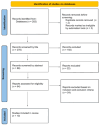Arthroscopic Management of Medial or Rotational Ankle Instability: A Comprehensive Review of Current Evidence
- PMID: 40565423
- PMCID: PMC12192630
- DOI: 10.3390/healthcare13121398
Arthroscopic Management of Medial or Rotational Ankle Instability: A Comprehensive Review of Current Evidence
Abstract
Introduction: Rotational ankle instability (RAI), involving combined medial and lateral ligament insufficiency, is an increasingly recognized clinical entity. While open surgery has traditionally been the mainstay for treating deltoid ligament injuries, recent developments in arthroscopic techniques offer a minimally invasive alternative. This systematic review aimed to evaluate the current evidence on the arthroscopic management of medial and rotational ankle instability, focusing on surgical techniques, clinical outcomes, and complications.
Methods: A systematic literature search was conducted following PRISMA guidelines using the PubMed, Scopus, and Web of Science databases. The search strategy included the following terms: ((rotation instability) OR (deltoid) OR (medial ankle instability)) AND (ankle arthrosc*). Eligible studies included adult patients undergoing arthroscopic repair of medial ankle instability with a mean 26.4 months follow-up and reported clinical outcomes. Ten studies met the inclusion criteria, encompassing 336 patients and 346 ankles.
Results: The mean patient age was 32.6 ± 5.0 years, with 80.6% being male. MRI was the primary diagnostic tool across most studies. Ankle sprains were the most common cause of instability. Lateral ligament insufficiency was frequently associated with medial injuries, reported in all studies evaluating this parameter. All patients underwent prior conservative treatment (mean duration: 5.6 months). Surgical management involved all-inside arthroscopic repair using knotless suture anchors. Additional procedures were performed in 90% of studies, including osteophyte resection (33.3%) and microfracture (22.2%). The mean follow-up period was 26.4 months. The mean postoperative AOFAS score was 95.3, with return to sport generally achieved between 3 and 5 months. Complications were minimal, primarily consisting of superficial wound issues and transient nerve irritation; no major complications or revision surgeries were reported.
Discussion: Arthroscopic management of medial and rotational ankle instability is associated with excellent functional outcomes, low complication rates, and early return to sport. Compared to open procedures, arthroscopic techniques offer advantages including reduced soft tissue trauma, fewer wound complications, and the ability to address concomitant intra-articular lesions in a single session. Although technically demanding, this approach is particularly beneficial in athletic populations. However, high-quality prospective studies are still needed to validate these findings and establish long-term comparative outcomes with open reconstruction techniques.
Keywords: ankle sprain; arthroscopy; deltoid ligament; ligament repair; medial ankle instability; rotational ankle instability; systematic review.
Conflict of interest statement
The authors declare no conflicts of interest.
Similar articles
-
Open and arthroscopic lateral ligament repair for treatment of chronic ankle instability: A systematic review.Foot Ankle Surg. 2018 Feb;24(1):11-18. doi: 10.1016/j.fas.2016.05.315. Epub 2016 May 12. Foot Ankle Surg. 2018. PMID: 29413768
-
Arthroscopic treatment for anterolateral impingement of the ankle: Systematic review and exploration of evidence about role of ankle instability.Orthop Traumatol Surg Res. 2022 Nov;108(7):103159. doi: 10.1016/j.otsr.2021.103159. Epub 2021 Nov 29. Orthop Traumatol Surg Res. 2022. PMID: 34856406
-
Surgical versus non-surgical interventions for displaced intra-articular calcaneal fractures.Cochrane Database Syst Rev. 2023 Nov 7;11(11):CD008628. doi: 10.1002/14651858.CD008628.pub3. Cochrane Database Syst Rev. 2023. PMID: 37933733 Free PMC article.
-
Arthroscopic repair of lateral ankle ligament complex by suture anchor.Arthroscopy. 2014 Jun;30(6):766-73. doi: 10.1016/j.arthro.2014.02.023. Epub 2014 Mar 27. Arthroscopy. 2014. PMID: 24680321
-
Surgical versus conservative treatment for acute injuries of the lateral ligament complex of the ankle in adults.Cochrane Database Syst Rev. 2002;(3):CD000380. doi: 10.1002/14651858.CD000380. Cochrane Database Syst Rev. 2002. Update in: Cochrane Database Syst Rev. 2007 Apr 18;(2):CD000380. doi: 10.1002/14651858.CD000380.pub2. PMID: 12137612 Updated.
References
-
- Chan K.W., Ding B.C., Mroczek K.J. Acute and chronic lateral ankle instability in the athlete. Bull. NYU Hosp. Jt. Dis. 2011;69:17–26. - PubMed
Publication types
LinkOut - more resources
Full Text Sources
Miscellaneous


